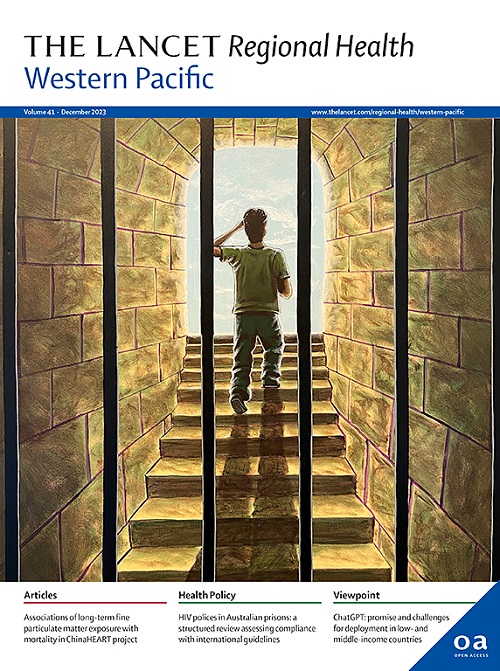Decitabine combined with reduced-intensity conditioning for older patients with acute myeloid leukemia in composite complete remission undergoing allogeneic hematopoietic stem cell transplantation: a multicenter, single-arm, phase 2 trial
IF 8.1
1区 医学
Q1 HEALTH CARE SCIENCES & SERVICES
引用次数: 0
Abstract
Background
Outcomes of older patients with acute myeloid leukemia (AML) undergoing allogeneic hematopoietic stem-cell transplantation (allo-HSCT) remain unsatisfactory. The primary objective of this trial was to establish whether decitabine combined with reduced-intensity conditioning (RIC) regimen could improve overall survival (OS) for this population in composite complete remission (CRc).
Methods
We conducted a single-arm, phase 2 trial at six hospitals in China. Eligible patients were aged 60–80 years, had a diagnosis of AML, achieved CRc at transplantation, were willing to undergo the first allo-HSCT, and had an Eastern Cooperative Oncology Group performance status of 0–2. Patients received decitabine combined with RIC regimen, comprising decitabine 20 mg/m2 daily intravenously (days −9 to −7), busulfan 3.2 mg/kg daily intravenously (days −5 to −4), and fludarabine 30 mg/m2 daily intravenously (days −6 to −3). The primary endpoint was 2-year OS rate. All efficacy and safety endpoints were assessed in the intention-to-treat population. This trial is registered with ClinicalTrials.gov (NCT03530085) and is complete.
Findings
Between Jan 1, 2021 and Nov 30, 2022, 60 patients were enrolled. With a median follow-up of 35.5 months (IQR 32.5–39.2), 39 patients survived and 21 died. The 2-year OS rate was 67% (95% CI 56–80), which met the primary objective. Within 100 days post-transplantation, the most common grade 3–4 non-hematological treatment-emergent adverse events (TEAEs) were infections (22 [37%]), acute graft-versus-host disease (21 [35%]), and gastrointestinal disorders (16 [27%]). Five (8%) patients died of TEAEs, with one death treatment-related.
Interpretation
Decitabine combined with RIC regimen exhibits encouraging OS and acceptable toxicity profile, which might be a suitable therapeutic option for older patients with AML.
Funding
National Natural Science Foundation of China; Science and Technology Program of Guangdong Province; National Key Research and Development Program of China.
地西他滨联合降低强度调理治疗接受同种异体造血干细胞移植的老年急性髓系白血病复合完全缓解患者:一项多中心、单臂、2期试验
背景:老年急性髓性白血病(AML)患者接受同种异体造血干细胞移植(alloo - hsct)的结果仍然不令人满意。该试验的主要目的是确定地西他滨联合降低强度调节(RIC)方案是否可以提高该人群复合完全缓解(CRc)的总生存期(OS)。方法:我们在中国6家医院进行了单臂2期试验。符合条件的患者年龄为60-80岁,诊断为急性髓性白血病,移植时达到结直肠癌,愿意接受第一次同种异体造血干细胞移植,东部肿瘤合作组成绩为0-2。患者接受地西他滨联合RIC方案,包括地西他滨20mg /m2每日静脉滴注(- 9至- 7天),布苏凡3.2 mg/kg每日静脉滴注(- 5至- 4天),氟达拉滨30mg /m2每日静脉滴注(- 6至- 3天)。主要终点为2年OS率。在意向治疗人群中评估了所有疗效和安全性终点。该试验已在ClinicalTrials.gov注册(NCT03530085),并且已经完成。在2021年1月1日至2022年11月30日期间,60名患者入组。中位随访35.5个月(IQR 32.5-39.2), 39例患者存活,21例死亡。2年OS率为67% (95% CI 56-80),达到了主要目标。移植后100天内,最常见的3-4级非血液学治疗不良事件(teae)是感染(22例[37%])、急性移植物抗宿主病(21例[35%])和胃肠道疾病(16例[27%])。5例(8%)患者死于teae,其中1例死亡与治疗相关。地西他滨联合RIC方案表现出令人鼓舞的OS和可接受的毒性特征,可能是老年AML患者的合适治疗选择。国家自然科学基金;广东省科技计划项目;国家重点研究与发展计划。
本文章由计算机程序翻译,如有差异,请以英文原文为准。
求助全文
约1分钟内获得全文
求助全文
来源期刊

The Lancet Regional Health: Western Pacific
Medicine-Pediatrics, Perinatology and Child Health
CiteScore
8.80
自引率
2.80%
发文量
305
审稿时长
11 weeks
期刊介绍:
The Lancet Regional Health – Western Pacific, a gold open access journal, is an integral part of The Lancet's global initiative advocating for healthcare quality and access worldwide. It aims to advance clinical practice and health policy in the Western Pacific region, contributing to enhanced health outcomes. The journal publishes high-quality original research shedding light on clinical practice and health policy in the region. It also includes reviews, commentaries, and opinion pieces covering diverse regional health topics, such as infectious diseases, non-communicable diseases, child and adolescent health, maternal and reproductive health, aging health, mental health, the health workforce and systems, and health policy.
 求助内容:
求助内容: 应助结果提醒方式:
应助结果提醒方式:


